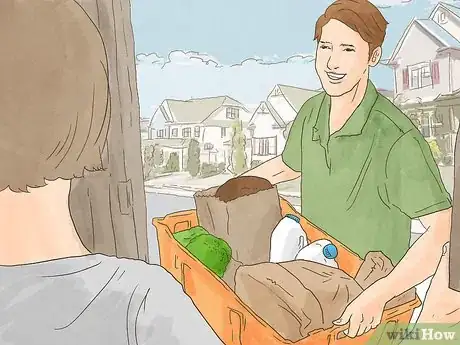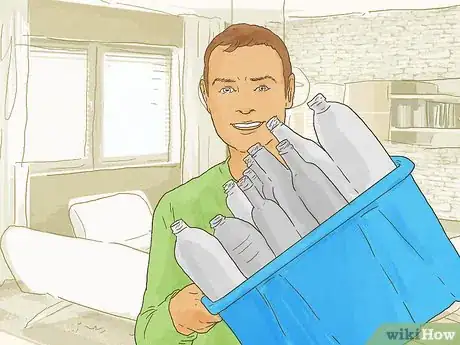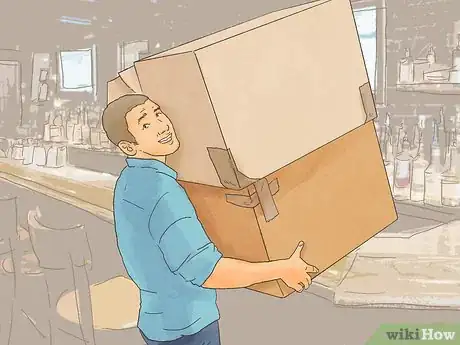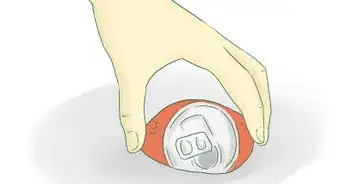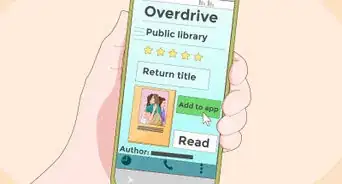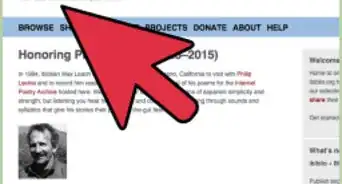This article was co-authored by wikiHow Staff. Our trained team of editors and researchers validate articles for accuracy and comprehensiveness. wikiHow's Content Management Team carefully monitors the work from our editorial staff to ensure that each article is backed by trusted research and meets our high quality standards.
wikiHow marks an article as reader-approved once it receives enough positive feedback. This article received 24 testimonials and 100% of readers who voted found it helpful, earning it our reader-approved status.
This article has been viewed 190,568 times.
Learn more...
A food bank is an organization that takes nonperishable food donations and distributes them to agencies or individuals in need of food. In the United States alone, over 49 million people lack access to sufficient nutritious food.[1] You can help fight hunger by starting a food bank of your own. Start by finding a space to hold your food, and set up a food drive to build up a food reserve. Then meet with clients in your community, and start distributing foods on a monthly or bi-weekly schedule.
Steps
Establishing Your Food Bank
-
1Find a place to store the food. The amount of donations you receive may vary throughout the year, so find a place large enough to accommodate the intake. If you're working with a local church or homeless shelter, they may have a spare pantry or other room that you can fill with food donations.[2]
- If you are operating on your own, you may be able to start by storing things in your basement or garage.
-
2Reach out to organizations in your area for food donations. Working with churches, schools, and local government agencies can help bring in food donations. These organizations can also recommend people in need of food supplies to help you build up a client base in your community.
- If there are other food banks in your area, notify them of your operation. Some banks may have food surpluses that you may be able to purchase, or they may be able to share helpful professional tips.
Advertisement -
3Hold meetings with prospective clients. Clients are the individuals and families who will be coming to your food bank to receive food. Follow up with clients that were recommended to you by other nearby organizations. You can also post flyers or advertisements around town to reach out in your community. Then, ask people who would like food assistance to meet with you. This will help you better assess the food-based needs of your community.[3]
- Figure out how many people (and families) you'll be providing food to, what kind of foods they need, and how often you should distribute.
-
4Gather necessary food-consumption information from clients. Ask individuals who use your service to write down their dietary needs, the size of their families, and any food allergies. These records can help you better assess what to prepare for them. You can also learn about what sort of food supplies you’ll need to gather in general.[4]
- It’s okay to ask how long an individual or family will need food assistance for, or what lead to them needing food assistance in the first place. Often it’s because of an injury or an illness.
- Remember to be respectful, though. Treat the talk more like a conversation than an interview.
Collecting Food Supplies
-
1Hold a food drive. This is the main method that food banks use to collect donations. To maximize the number of people who find out about, and donate to, your food drive, contact local schools, churches, office buildings, or gyms and ask if they'd be willing to host. Specify which types of food you would like to collect (e.g. canned goods, breads and pasta, etc.). Then, hang posters or flyers around your area of town to draw attention to the drive.[5]
- You can also ask local grocery stores to donate to your food drive. It gives them good publicity, and will dramatically increase the amount of food you collect.
-
2Collect food donations from a drop-off bin. Food-bank donation boxes are often set up outside a local grocery store, office, or other local business. If you want to set up a drop-off bin in front of an existing business, make sure you have permission from the business owner first.[6]
- At times when items aren’t coming in through the drop-off bin, you may need to purchase food when your reserves are low.
-
3Reach out to local grocery stores for food donations. Stop by store locations in person, and explain that you’re starting up a community food bank. Ask if the store regularly has any food items that, rather than throwing away, they could donate to the bank. Grocers will likely be willing to donate items that are reaching the sell-by dates and other leftover foods.[7]
- If grocery store managers are skeptical of your claim, you could show them a piece of mail with the food bank’s name and address on it. Alternately, invite them to come by the food bank on a day when you’re distributing food.
- Also, remind grocers that they won’t lose money by donating food, since they’d likely be throwing the food away otherwise.
- If grocery stores agree to donate, you'll likely need to drive to the stores. Don't expect grocery stores to bring the food to you.
-
4Process items as they come in. Have shelving set up in your bank area to separate the items according to product type (e.g. canned goods, boxes, breakfast items, fresh food, dried goods). Double check expiration dates and throw out any that are past the freshness date.[8]
-
5Store dietary alternative items apart from the rest. When you collect items that have a specific base (like gluten-free, dairy-free, or sugar-free foods), store them in their own area. When individuals come to the bank who may be diabetic or have special food needs, allow them to look at the items directly and pick out a few they would like.[9]
- For example, these items could be kept in a distinct section of shelving or cabinets.
Distributing Food to Your Community
-
1Set up a distribution schedule. Once you have food to distribute, figure out when people or agencies will receive food from you. Some food banks may only disperse donations once or twice a month, while others give out food nearly every day. Get in touch with your prospective clients and inform them of the hours during which the food bank will be open, and when they can pick up their food.[10]
- You may also be able to work with other food banks in your community. For example, if you alternate weeks on which each food bank distributes food, you'll help a larger portion of the community.
-
2Prepare boxes of food donations. It's best if you put these together the day before you will disperse them, so you're not scrambling to fill boxes while clients wait. Try to have a variety of foods in each box.[11] For example, each box could have a loaf of bread, a protein (like peanut butter) a few cans of soups or vegetables, and pasta.
- If you are packaging for individuals, keep in mind the amount of people the food has to feed and pack accordingly.
-
3Charge clients a small fee. Although some food banks have legal non-profit status and do not charge their clients, many food banks do require that the individuals who need food assistance pay for food. This is typically a minimal fee, say $5 or $10 per week. This fee will help offset your operations expenses, and will enable you to purchase good during months when your donations are slow.[12]
- If clients need food but are unable to pay, you could charge a nominal fee. For example, ask for 5¢.
-
4Search for additional funding. Food donations can decrease during certain times of the year, especially around the holidays when they are needed the most. Reach out to local community groups for monetary funding or check for government funding programs. By getting additional funding, you will be able to fight hunger on a more consistent basis.
- You can also reach out to large, nation- or world-wide food bank organizations for assistance with both finances and food. Organizations like Feeding America work with local or regional food banks.[13]
Community Q&A
-
QuestionI want to start a food bank in my hometown. Can you tell me where to start?
 Community AnswerYou can start a food bank in a church or a school. If they have a donation bin, decorate it so that people ask: "What's this? I've never seen this before, oh it's a food pantry, I should donate". Collect the donations regularly and begin distributing them as needed.
Community AnswerYou can start a food bank in a church or a school. If they have a donation bin, decorate it so that people ask: "What's this? I've never seen this before, oh it's a food pantry, I should donate". Collect the donations regularly and begin distributing them as needed. -
QuestionWhat's the first step in starting a food bank?
 Community AnswerGet support behind you. A lot of these things are difficult to do alone.
Community AnswerGet support behind you. A lot of these things are difficult to do alone. -
QuestionHow do I start a food bank for my church?
 Community AnswerAsk your pastor or priest for permission. Then, gather a few people from your church to help you start and manage the food bank.
Community AnswerAsk your pastor or priest for permission. Then, gather a few people from your church to help you start and manage the food bank.
Warnings
- Do not take food that will spoil easily or has a short shelf life. Fresh fruits and vegetables should only be included if they will be consumed before they spoil.⧼thumbs_response⧽
References
- ↑ http://articles.bplans.com/how-to-start-a-food-pantry/
- ↑ http://articles.bplans.com/how-to-start-a-food-pantry/
- ↑ http://articles.bplans.com/how-to-start-a-food-pantry/
- ↑ https://www.endhungerinamerica.org/publications/how-to-run-a-food-pantry/chapter-4-clients-and-hours-and-intake-oh-my/
- ↑ http://www.moveforhunger.org/food-drive-tips/
- ↑ http://articles.bplans.com/how-to-start-a-food-pantry/
- ↑ http://articles.bplans.com/how-to-start-a-food-pantry/
- ↑ https://www.endhungerinamerica.org/publications/how-to-run-a-food-pantry/chapter-3-food-handling/
- ↑ https://www.endhungerinamerica.org/publications/how-to-run-a-food-pantry/chapter-3-food-handling/
- ↑ https://www.endhungerinamerica.org/publications/how-to-run-a-food-pantry/chapter-4-clients-and-hours-and-intake-oh-my/
- ↑ http://articles.bplans.com/how-to-start-a-food-pantry/
- ↑ https://www.entrepreneur.com/answer/221923
- ↑ https://www.endhungerinamerica.org/publications/how-to-run-a-food-pantry/chapter-2-finding-food/
About This Article
If you want to help fight hunger, you can start a food bank to distribute food to your community on a monthly or weekly basis. Find a place large enough to store the food you hope to amass during the year. If you’re working with a church or shelter, see if they have a spare pantry or closet that you can use, or see if you have enough room in your garage or basement. Reach out to churches, schools, and local government agencies about helping collect food donations. These people can also recommend people or groups in need of food. Try to meet with the people you’ll be serving to figure out how many people or families you’ll be providing for, what kinds of food they’ll need, and how often they’ll need it. Based on this information, set up a distribution schedule, like once a week or once a month. Then, fill boxes with the food items, like a loaf of bread, a jar of peanut butter, canned veggies and fruits, and boxes of pasta, the day prior to pickups. To learn how to get additional funding for your food bank, keep reading!




